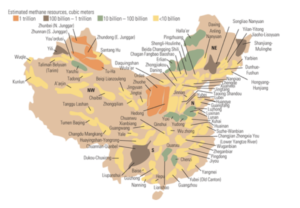by Amy Hawkins, October 22, 2019 in The Times
China is expanding its coal power infrastructure despite pledges to curb carbon emissions.
Analysis reveals that the amount allocated to large infrastructure projects by Beijing has doubled this year, with airports and high-speed rail lines among 21 schemes allocated a total of £83.9 billion.
Included in the new allocations is funding for 17 new coal mines across China, despite Beijing’s pledges to reduce reliance on the power source.
Seven mines were approved last year and, between 2017 and 2018, China added 194 million tonnes of coal mining capacity with the total number of mines reaching more than 3,000.
China, the world’s biggest coal consumer, has vowed to cap carbon emissions by 2030, although it has stopped short of the “net zero” emissions target by 2050…

China’s coal basins and coalbed methane resources. Source: Caterpillar Inc.

China consumes more coal than all other nations together
by N. Thurner, October 25, 2019 in ClimateChageDispatch
If you believe the debate over global warming has ever been about science—or for that matter climate—you have been conditioned, through formal education or through reports warning of doom and gloom, to believe what others rightly describe as a world-wide hoax concocted to unite the world under a single socialistic government where there is no capitalism, no democracy, and no freedom.
Why is exposing the truth so important? Because it has everything to do with the redistribution of wealth and the establishment of political agendas aimed at destroying the foundation of eastern democracies and free markets.
Accordingly, it is therefore critical for everyone to become informed so free and open debate can exist, rather than the suppression and falsification of actual scientific climate data.
This article will expose some of the popular climate myths about CO2, so the reader will be equipped with ammunition to spread the truth to those who are willing to listen and have not yet become environmental extremists.
Links are included after each myth to substantiate information and to provide reference material for further interest and clarification.
The article was written using individual articles, with permission from my friend Jay Lehr, Ph.D., in which he exposed popular climate myths related to CO2. Jay Lehr is a Senior Policy Analyst for The International Climate Science Coalition.
Myth #1: Carbon dioxide emissions cause catastrophic global warming.
…
by Roy Spencer, October 25, 2019 in GlobalWarming
The UN IPCC scientists who write the reports which guide international energy policy on fossil fuel use operate under the assumption that the climate system has a preferred, natural and constant average state which is only deviated from through the meddling of humans. They construct their climate models so that the models do not produce any warming or cooling unless they are forced to through increasing anthropogenic greenhouse gases, aerosols, or volcanic eruptions.
This imposed behavior of their “control runs” is admittedly necessary because various physical processes in the models are not known well enough from observations and first principles, and so the models must be tinkered with until they produce what might be considered to be the “null hypothesis” behavior, which in their worldview means no long-term warming or cooling.
What I’d like to discuss here is NOT whether there are other ‘external’ forcing agents of climate change, such as the sun. That is a valuable discussion, but not what I’m going to address. I’d like to address the question of whether there really is an average state that the climate system is constantly re-adjusting itself toward, even if it is constantly nudged in different directions by the sun.
…

1575 Winter Landscape with Snowfall near Antwerp by Lucas van Valckenborch.Städel Museum/Wikimedia Commons
…
Prof. Igr. H. Masson, 25 octobre 2019 in ScienceClimatEnergie
1. Un nouveau paradigme : les systèmes chaotiques
« Depuis les premiers balbutiements de la Physique, le désordre apparent qui règne dans l’atmosphère, dans la mer turbulente, dans les fluctuations de populations biologiques, les oscillations du cœur et du cerveau ont été longtemps ignorées ».
« Il a fallu attendre le début des années soixante-dix, pour que quelques scientifiques américains commencent à déchiffrer le désordre, il s’agissait surtout de mathématiciens, médecins, biologistes, physiciens, chimistes cherchant tous des connections entre diverses irrégularités observées. Le syndrome de la mort subite fut expliqué, les proliférations puis disparitions d’insectes furent comprises et modélisées, et de nouvelles méthodes d’analyse de cours boursiers virent le jour, après que les traders aient dû se rendre à l’évidence que les méthodes statistiques conventionnelles n’étaient pas adaptées. Ces découvertes furent ensuite transposées à l’étude du monde naturel : la forme des nuages, les trajectoires de la foudre, la constitution de galaxies. La science du chaos (« dynamical systems » pour les anglo-saxons) était née et allait connaître un développement considérable au fil des années ».
…
…

Figure 4. L’effet papillon : analogie entre les ailes d’un papillon et l’attracteur étrange découvert par E. Lorenz.
…
La géologie, une science plus que passionnante … et diverse




